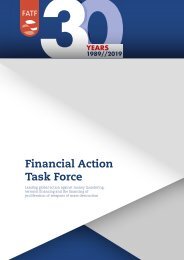Money Laundering from Environmental Crime
A summary of the key findings for public and private sectors of the FATF's report on Money Laundering from Environmental Crime.
A summary of the key findings for public and private sectors of the FATF's report on Money Laundering from Environmental Crime.
Create successful ePaper yourself
Turn your PDF publications into a flip-book with our unique Google optimized e-Paper software.
MONEY LAUNDERING FROM ENVIRONMENTAL CRIME
WHAT ARE THE KEY LAUNDERING RISKS
FOR ENVIRONMENTAL CRIMES?
FATF’s report highlights that criminals involved in environmental crimes launder
their proceeds through the formal and informal financial sector across countries.
This includes financial, trade and company formation centres, which may not have
natural resources domestically.
Criminals frequently mix or “comingle” legal and illegal products early in the
resource supply chains to conceal their illicit source, including relying on complicit
intermediaries along resource supply chains (e.g. refiners, sawmills). This can make
it particularly difficult to differentiate legal and illegal financial flows later on in the
value chain.
Networks for forestry crime, illegal mining and waste trafficking also rely on tradebased
fraud, and corruption and bribery of politically exposed persons, to exploit
weak regulatory oversight in environmental resource chains.
These same networks will make use of complex corporate structures, shell
companies and intermediaries (e.g., accountants, lawyers, etc.) to conceal financial
flows and employ offshore jurisdictions, to facilitate placement and/or layering of
funds, which underscores the importance of identifying the underlying owners.




